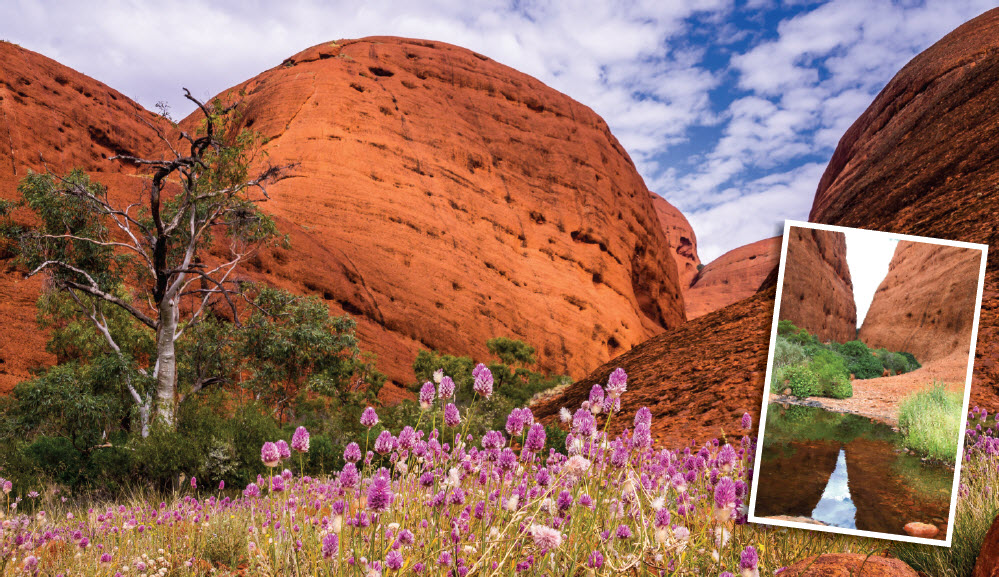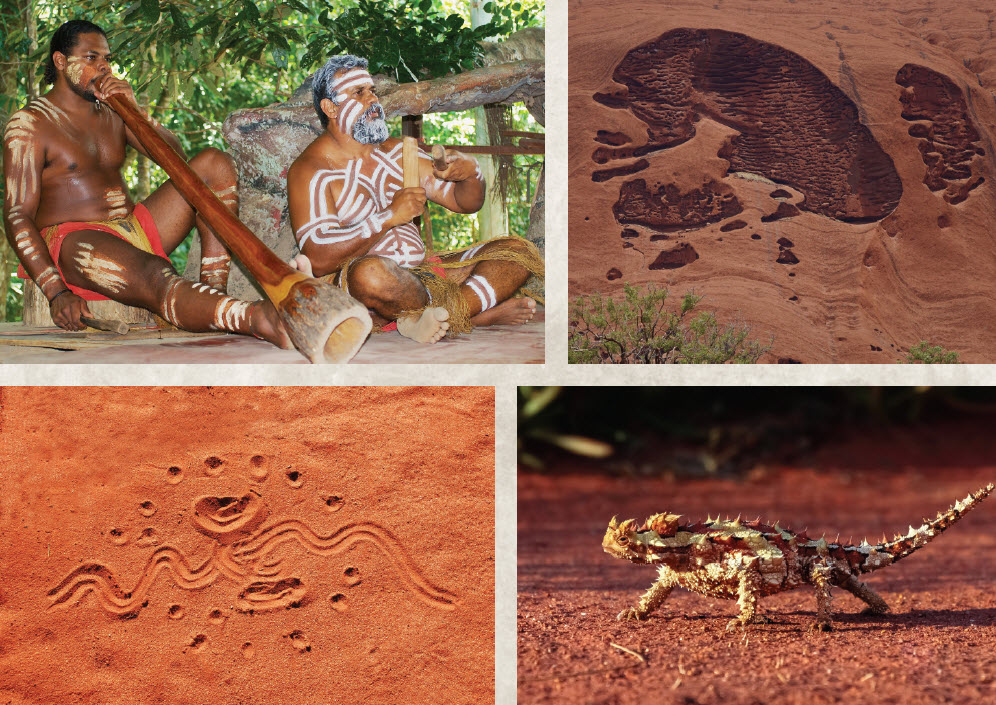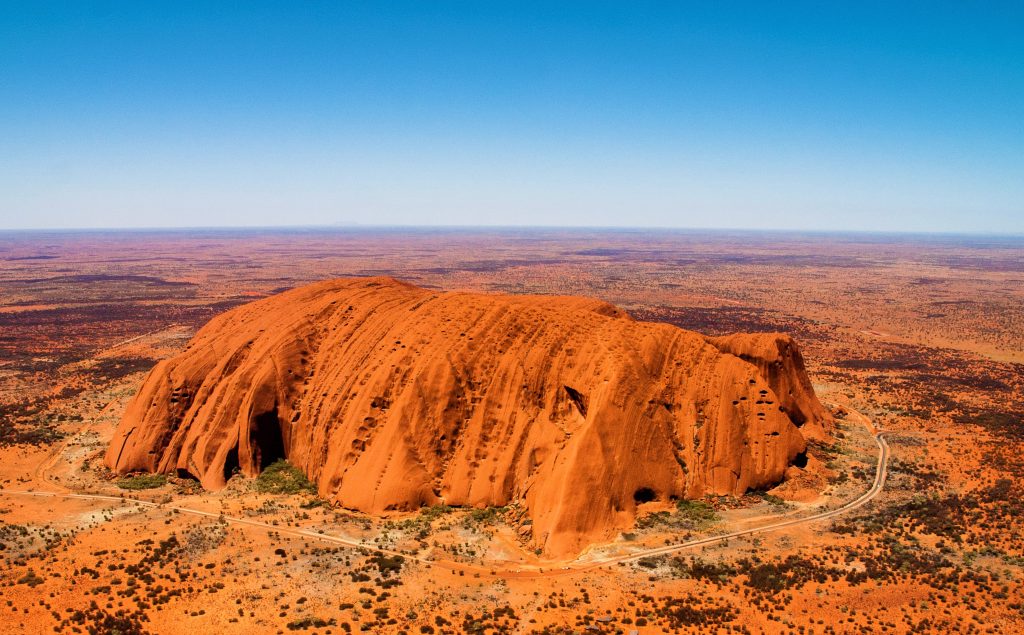Nothing quite prepares you for the magnitude of the sandstone monolith that is Uluru and the 36 red domes of Kata Tjuta, pushing up through the Earth’s crust. Uluru is a sacred site for the Aboriginal tribes and has great spiritual meaning. Whether it’s the Icelandic sagas or the Aboriginal walkabout, ritual journeys are deeply ingrained in the human psyche.
“Near the heart of Australia, from the parched dry plains of the Northern Territory, rises the biggest monolith in the world, the colossal Uluru, called Ayers Rock by settlers. The ownership of the rock was transferred to the Aboriginals of the area and it regained its Aboriginal name of Uluru, which means Great Pebble. Uluru is one of earth’s great natural wonders. Consisting of mineral-rich sandstone, Uluru measures 2.4km long and 1.6km wide and rises up to 867 metres above sea level. Each feature of the rock has a meaning in ‘Tjukurpa or Dreamtime, the traditional Anangu lore that explains how the world was created. The caves in the rock have been decorated with Aboriginal paintings and prehistoric art, some of which indicate such things as the whereabouts of water and other vital information. Others were painted for religious purposes and as a means of both storytelling and, for a culture with no written language, to teach and record its history. Twenty-five km to the west, bigger, wider and taller than Uluru, Kata Tjuta is a spectacular collection of 36 enormous rocks. Uluru might be taller than the Eiffel Tower, but Kata Tjuta towers another 200m higher than that; it would dwarf even New York City’s Empire State Building.”
The approach into Uluru from the air is surreal. The runway is dwarfed by the colossus of the red-orange rock under a clear, electric blue sky. The oddly spectacular, never-ending landscape, dotted with sporadic green islands in an ochre lake, pours over the edge of the horizon. On disembarking, you are hit in the face by intense dry heat rising up, the hot dusty air burning your throat as you take a breath at the top of the aircraft steps.
The myth and magic of ‘the Rock’ (as it is called by the Australian people) begin to set off my energy centres with a fair amount of tingling, the heat of the day long forgotten as anticipation of what is to come reverberates through me. If, like me, you are the sort of person who relishes the mysticism and fable in epic poems like Homer’s the Iliad and the Odyssey and the warriors and heroes dominant in those societies from which they sprung, you will love the Rock: Storytelling, fables and teachings for the Anangu people, handed down from generation to generation.
The experiencing of these mysteries, written into the faces of the Rock, since it was birthed from Tjukurpa, the Dreamtime (before which, in the aboriginal view, the earth did not exist), proves to be one of the most humbling and uplifting journeys of my life.
My daughter and I have travelled to Uluru from Brisbane. It is a treat and celebration of togetherness for us, living on separate continents, yet each of us is on a personal journey, our walkabout. Coming through the road mirage on the shuttle we are greeted by Ghost Gums with their stark white bark on the ochre landscape as the Desert Gardens come in into view. Walking through the doors and abundant indigenous flowering desert shrubs, we are greeted by a shock of welcome cool air. On arrival we notice that most of the other travellers are wearing nets over their faces and heads which we find rather odd.
We settle into our luxurious room surrounded by a forest of Ghost Gums with a distant view of the Rock. We have arrived, notable flutters of excitement circulate in my belly… it is time set off to find refreshment for our parched throats and explore the Uluru Town Square. In the 10-minute walk from our oasis to the square we are plagued by what feels like ten thousand flies – we cannot speak without swallowing a fly and hold our hands over our noses so as not inhale them either. Our first stop: The souvenir shop where we buy our head nets. Next stop – car hire for the intrepid adventurers as we are about to set off for our first Uluru sunset.
Travelling independently enables us to touch the silence we are so desperately seeking and connect intimately with the energy and teachings of Uluru and Kata Tjuta.
As you stand on the iron-rich sands around Uluru National Park sipping a cold drink, the landscape begins to change. As the sun dips towards the horizon behind you, the event becomes more beautiful every minute, until the crescendo into the Uluru sunset experience about a minute before sunset. The Rock is dowdy brown around midday; as the afternoon progresses, the redness deepens and becomes intense due to the iron oxide coating on the rock. As the sun is about to drop down to the horizon, red light streams through the atmosphere hitting the red rock of Uluru. Just after this, the shadow of the earth’s horizon appears on the lower levels of Uluru and quickly and visibly moves up the face of Uluru, covering it completely.
The sky darkens to a deep indigo and the last rays of the sun slip beyond the horizon; the Uluru night sky is lit by trillions of stars. The land and its iconic rocks, so dominant during the day, disappear into the dark and the night sky comes to life. Stargazing is the perfect yin to the yang of daytime exploits. You totally get lost in the stars… it’s quite simply magical and, in that moment, you consider the magnitude of the galaxies, universes known and unknown and inner knowingness confirms that there is so much more out there beyond all conception.
We leave our oasis at dawn to make the journey to Kata Tjuta. The first stop is to Uluru-Kata Tjuta National Park’s sunrise dune viewing platform, from which we watch in silent awe. We travel another 18km to Kata Tjuta’s entrance. Walking through Kata Tjuta has been compared to what a walk through Uluru might be like if you sliced the giant rock in half – and the site’s most popular walking track, a 2.6km round trip into Walpa Gorge, certainly feels that way. The easy stroll between two of the largest domes offers a breathtaking sense of scale, with the reward of a beautiful riverbed and small oasis of green at its end.
Every shade and texture of ochre, crimson, maroon, rust and slate can be found on the rock walls; the valleys between them filled with soft grey gums, shining emerald shrubs and the pale-green fuzz of spinifex. Surreal pink and orange clouds puff slowly through the sky above and the overall impression is of another world, a slip down the rabbit hole into a psychedelic wonderland.
The Anangu are notoriously quiet about their cultural practices and Kata Tjuta is known as a place of ‘men’s business’. So while outsiders are welcome to visit, no one can broadcast the experience with the world. Respectfully we only take precious few photographs of the trail through the rock to Wolpa Gorge and only when invited to do so. Our personal experiences there shall remain recorded only in our hearts.
Unlike Uluru there are no man-made visual interruptions to be seen at Kata Tjuta: No boardwalks, no handrails and no signage. It is a place of great secrets and little is known about Kata Tjuta’s place in indigenous life. I never fully grasped the relationship these people had to the land, until my life-changing visit to these vibrant red domes.
As you drive toward Uluru you realise that it is not one rock but many rocks forged together in nature’s geometric precision, a geological wonder made up of sharp corners, jagged cliffs, deep recesses and sweeping fin-like curves.
As we begin to explore the base of Uluru, the tranquillity and stillness are unexpected, interrupted only by birdsong (there are 178 bird species in the national park) – or the scuttling of a lizard through the spinaflex grass. Even the flies seem less agitated and aggressively persistent. Making our way around, we find honeycombed crevices and wonderful caves to explore, taking in the imagery of the ancient rock art on the internal cave walls. It was in one such cave in ‘the place of women’s business’ that I met my aboriginal spirit guide.
Drawn into the cave by gentle yet excited energy, I found a comfortable, smooth rock in a caverned room to sit on. This space may, at some time many moons before, have served as a gathering place for the women as they lit their night fires. As I drift into the silence, vivid imagery of a crone, an elder and storyteller, come into focus, women and children gathered around her. This is the place where the accounts of ‘The Dreaming’, stories of a period of creation before time as we know it existed, were handed down. As I stand up to leave the comfort of this womb-like cavern, a small bent woman with a shock of hair begins to walk beside me, aided by a rustic walking stick that is beginning to sprout a few leaves. She introduces herself and asks me to stay a while longer as she has a story of great importance to share with me. She says that she will walk beside me as I am a storyteller for my people as she was to hers. As an aspirant author I am delighted at the possibility of a story which will inspire a publishing house.



Shortly after meeting this diminutive, earthy and somewhat elemental guide with piercing eyes who has patiently awaited my arrival at Uluru, I walk through an enchanting, tree-lined pathway, noticing a bench that seems like the perfect place to contemplate this profound experience. As I walk towards the bench, I am drawn to a series of story boards, in close proximity to the cooking area in the ‘place of women’s business’ where I met my guide. They read…
Look at the landscape as we do and know these ancestors are still here. This is the right place to learn about this story because it happened here at this place. Look, take note of what you see. Have a think and take in your surroundings.
This is a place of great history, an important place.
“In the beginning, the Mala people came from the north and could see this rock (Uluru). They thought it looked like a good place to stay a while and make inma (ceremony). The Mala men decorated and raised Ngaltawata, the ceremonial pole. The inma had now begun.
The Mala people began busily to prepare for their ceremonies. The women gathered and prepared food for everyone. They stored nyuma (seed cakes) in their caves. The men went out hunting. They made fires and fixed their tools and weapons.
In the middle of preparations, two Wintalka men approached from the west. They invited the Mala people to attend their inma. The Mala people said no, explaining their ceremony had begun and could not be stopped.
The disappointed Wintalka men went back and told their people. Enraged, they created an evil spirit – a huge devil-dog called Kurpany – to destroy the Mala inma.
As Kurpany travelled towards the Mala people he changed into many forms. He was a mamu, a ghost. Luunpa, the kingfisher woman was the first to spot him. She warned the Mala people but they didn’t listen.
Kurpany arrived and attacked and killed some of the men. In great fear and confusion the remaining Mala people fled down into South Australia with Kurpany chasing them. The story continues down south.
These ancestors are still here today. Luunpa still keeps watch, but she is now a large rock. Kurpany’s footprints are imprinted into the rock heading towards the east and south. The men who were killed are still in their cave.”
This story teaches that it is important to finish what you start and that you should watch for and listen to warnings of danger.
I am grateful for the wealth of opportunity that has arisen and the means which have manifested to put me in a position to pursue this, my personal Odyssey, and the teachings along the way. I have learned many profound lessons and look forward in anticipation of those I have yet to learn and experience. I remain forever reminded by this leg of my journey – to take the plunge, take heed and keep a lookout for danger along the way and… always to finish what I start.
I am honoured and grateful to have shared this part of my journey with you and as I prepare to embark on my next walkabout and bid farewell … but not goodbye to you all. My custodianship of Odyssey Magazine has been one of the greatest gifts and joys of my life and I am so grateful to each and every reader, author, thought leader and advertiser who has been instrumental in my journey with this ‘grand old gal’ that is Odyssey.
As this magazine reaches the shelves 24 October, this personal spiritual journey as the custodian of Odyssey Magazine since November 2018 has been an exploration of my inner self, it’s had significant meaning, purpose and connection of something greater than me. Odyssey Magazine has an energy and a path, a journey it is destined to undertake and I believe that Odyssey Magazine selects its own custodian, leading to a continuum of consciousness growth. All that connect with this significant 49-year-old energy embark on an exceptional and entirely unique journey of self-discovery, reflection and profound shift.
Uluru and Kata Tjuta are located on the third of the Earth’s chakra points. These chakra points are where energetic ley lines intersect. Uluru is a focal point as the ‘north pole’ of the southern hemisphere.
As a shaman, a seeker and a traveller to this magnificent and sacred part of our planet I respectfully acknowledge the Aboriginal ancestors and recognise all Aboriginal and Torres Strait Islander peoples honouring their deep and ancient connection to the land.
In light, in love and in connection with you always
Debra



